MAZDA MODEL TRIBUTE 2001 (in English) Manual PDF
Manufacturer: MAZDA, Model Year: 2001, Model line: MODEL TRIBUTE, Model: MAZDA MODEL TRIBUTE 2001Pages: 232, PDF Size: 2.4 MB
Page 71 of 232

4. Flip seat forward.
5. Pull the seatback release strap
toward the front seat. Make
sure the seat belt buckle heads
are fully extended towards the
front of the vehicle and are
away from the seatback.
NOTE:When the seatback release
strap is pulled use your other hand
to guide the seatback.
Seating and safety restraints
71
Page 72 of 232
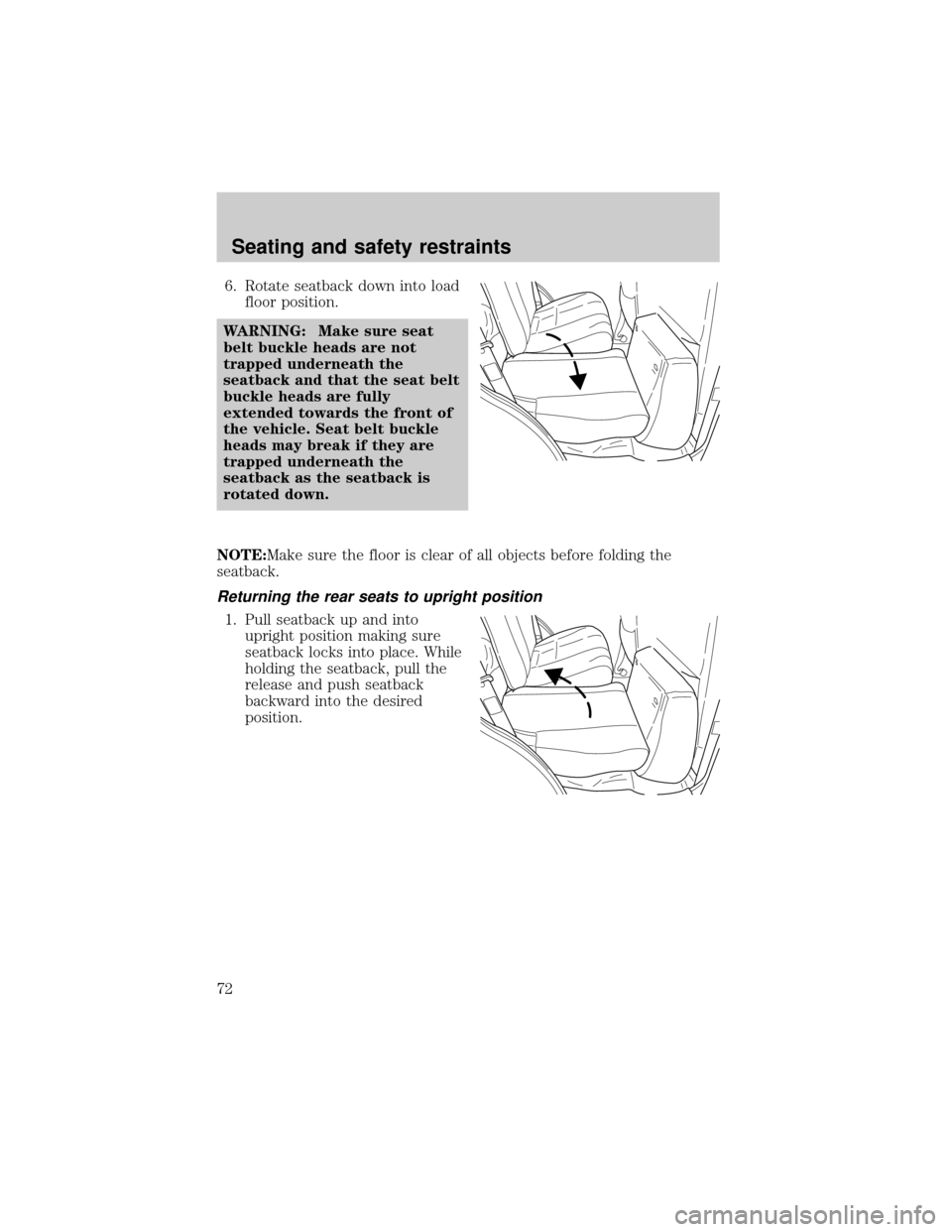
6. Rotate seatback down into load
floor position.
WARNING: Make sure seat
belt buckle heads are not
trapped underneath the
seatback and that the seat belt
buckle heads are fully
extended towards the front of
the vehicle. Seat belt buckle
heads may break if they are
trapped underneath the
seatback as the seatback is
rotated down.
NOTE:Make sure the floor is clear of all objects before folding the
seatback.
Returning the rear seats to upright position
1. Pull seatback up and into
upright position making sure
seatback locks into place. While
holding the seatback, pull the
release and push seatback
backward into the desired
position.
Seating and safety restraints
72
Page 73 of 232

2. Rotate seat cushion down into
the seating position making sure
that the seat cushion is locked
into place and that the seat belt
buckles are exposed.
3. Remove the head restraints stored under the front passenger seat
and return them to the original position on the seat backs.
To remove the rear cushion
1. Pull the Yellow tab
2. Pull the cushion to the outboard
side of the vehicle.
Seating and safety restraints
73
Page 74 of 232

To install the rear cushion
1. Push the cushion to the inboard
side of the vehicle.
2. Make sure that the hinges are
locked into place.
SAFETY RESTRAINTS
Safety restraints precautions
WARNING: Always drive and ride with your seatback upright
and the lap belt snug and low across the hips.
WARNING: To reduce the risk of injury, make sure children sit
where they can be properly restrained.
WARNING: Never let a passenger hold a child on his or her lap
while the vehicle is moving. The passenger cannot protect the
child from injury in a collision.
WARNING: All occupants of the vehicle, including the driver,
should always properly wear their safety belts, even when an
air bag SRS is provided.
Seating and safety restraints
74
Page 75 of 232
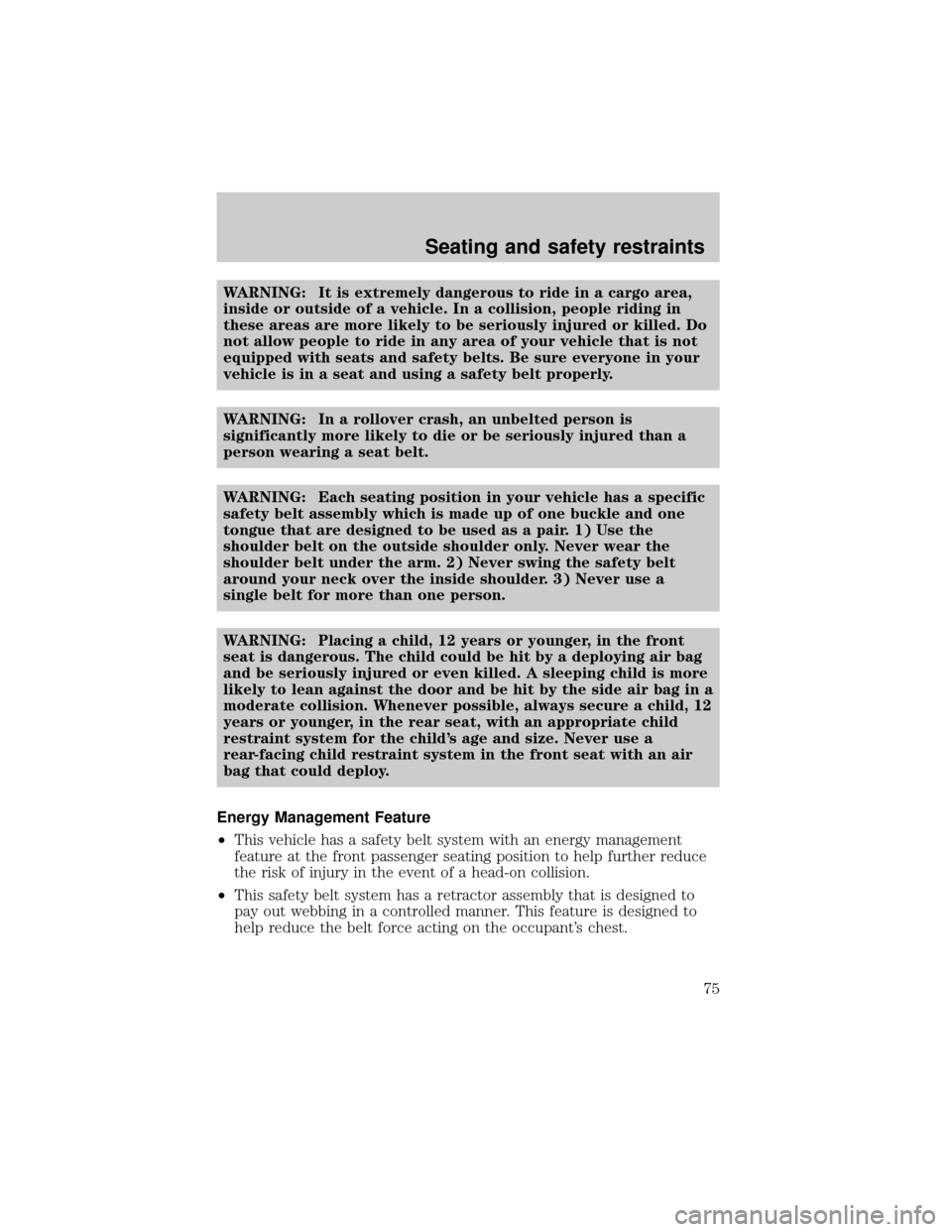
WARNING: It is extremely dangerous to ride in a cargo area,
inside or outside of a vehicle. In a collision, people riding in
these areas are more likely to be seriously injured or killed. Do
not allow people to ride in any area of your vehicle that is not
equipped with seats and safety belts. Be sure everyone in your
vehicle is in a seat and using a safety belt properly.
WARNING: In a rollover crash, an unbelted person is
significantly more likely to die or be seriously injured than a
person wearing a seat belt.
WARNING: Each seating position in your vehicle has a specific
safety belt assembly which is made up of one buckle and one
tongue that are designed to be used as a pair. 1) Use the
shoulder belt on the outside shoulder only. Never wear the
shoulder belt under the arm. 2) Never swing the safety belt
around your neck over the inside shoulder. 3) Never use a
single belt for more than one person.
WARNING: Placing a child, 12 years or younger, in the front
seat is dangerous. The child could be hit by a deploying air bag
and be seriously injured or even killed. A sleeping child is more
likely to lean against the door and be hit by the side air bag in a
moderate collision. Whenever possible, always secure a child, 12
years or younger, in the rear seat, with an appropriate child
restraint system for the child's age and size. Never use a
rear-facing child restraint system in the front seat with an air
bag that could deploy.
Energy Management Feature
²This vehicle has a safety belt system with an energy management
feature at the front passenger seating position to help further reduce
the risk of injury in the event of a head-on collision.
²This safety belt system has a retractor assembly that is designed to
pay out webbing in a controlled manner. This feature is designed to
help reduce the belt force acting on the occupant's chest.
Seating and safety restraints
75
Page 76 of 232
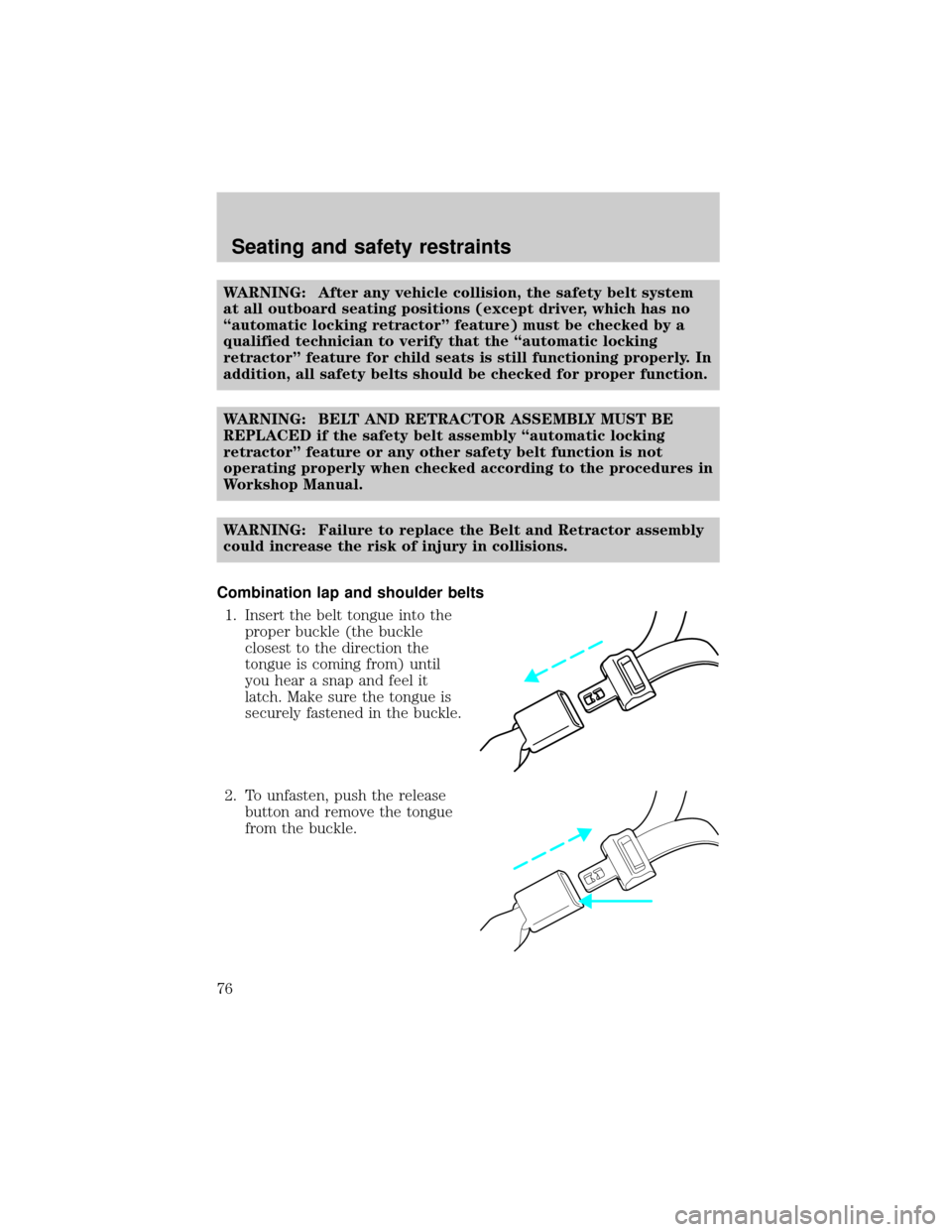
WARNING: After any vehicle collision, the safety belt system
at all outboard seating positions (except driver, which has no
ªautomatic locking retractorº feature) must be checked by a
qualified technician to verify that the ªautomatic locking
retractorº feature for child seats is still functioning properly. In
addition, all safety belts should be checked for proper function.
WARNING: BELT AND RETRACTOR ASSEMBLY MUST BE
REPLACED if the safety belt assembly ªautomatic locking
retractorº feature or any other safety belt function is not
operating properly when checked according to the procedures in
Workshop Manual.
WARNING: Failure to replace the Belt and Retractor assembly
could increase the risk of injury in collisions.
Combination lap and shoulder belts
1. Insert the belt tongue into the
proper buckle (the buckle
closest to the direction the
tongue is coming from) until
you hear a snap and feel it
latch. Make sure the tongue is
securely fastened in the buckle.
2. To unfasten, push the release
button and remove the tongue
from the buckle.
Seating and safety restraints
76
Page 77 of 232
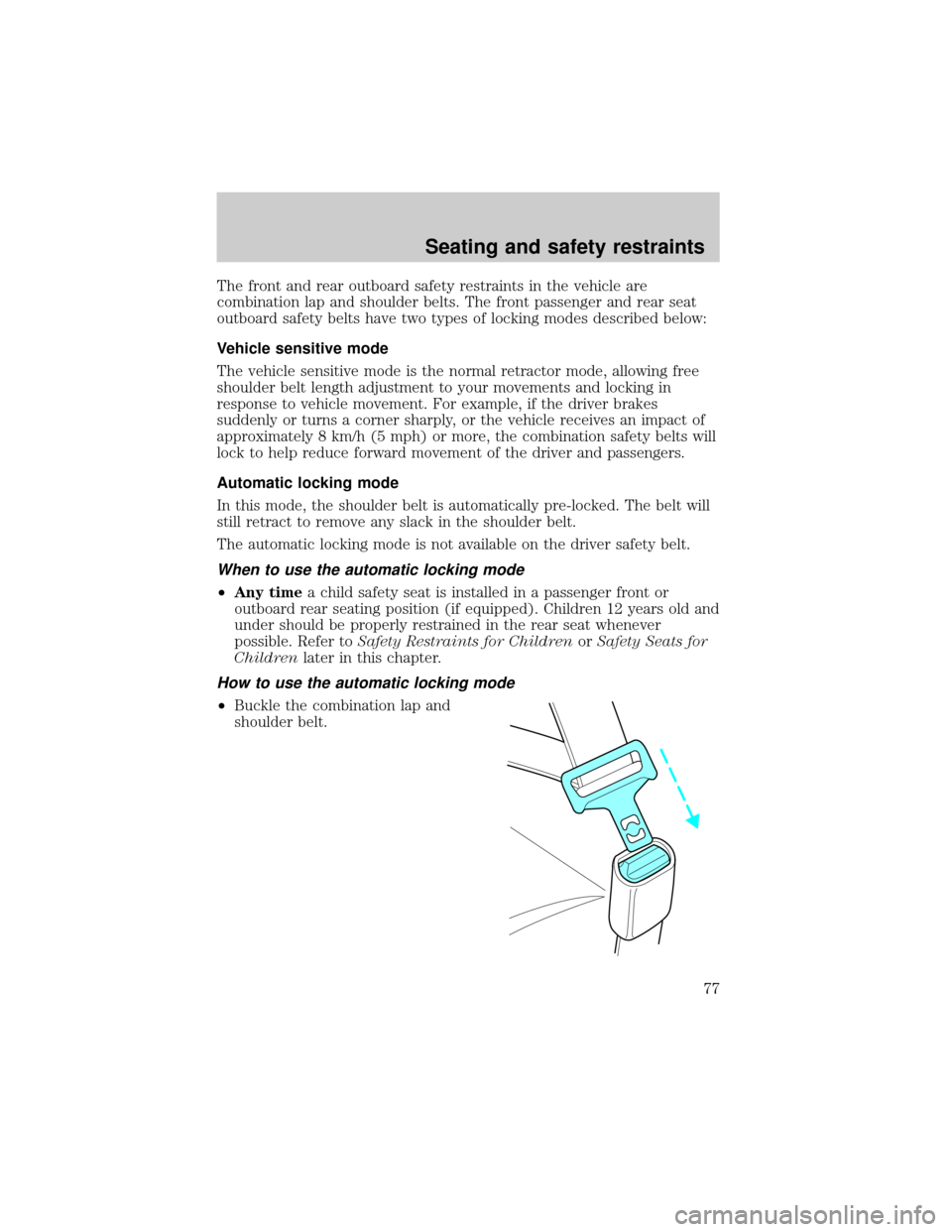
The front and rear outboard safety restraints in the vehicle are
combination lap and shoulder belts. The front passenger and rear seat
outboard safety belts have two types of locking modes described below:
Vehicle sensitive mode
The vehicle sensitive mode is the normal retractor mode, allowing free
shoulder belt length adjustment to your movements and locking in
response to vehicle movement. For example, if the driver brakes
suddenly or turns a corner sharply, or the vehicle receives an impact of
approximately 8 km/h (5 mph) or more, the combination safety belts will
lock to help reduce forward movement of the driver and passengers.
Automatic locking mode
In this mode, the shoulder belt is automatically pre-locked. The belt will
still retract to remove any slack in the shoulder belt.
The automatic locking mode is not available on the driver safety belt.
When to use the automatic locking mode
²Any timea child safety seat is installed in a passenger front or
outboard rear seating position (if equipped). Children 12 years old and
under should be properly restrained in the rear seat whenever
possible. Refer toSafety Restraints for ChildrenorSafety Seats for
Childrenlater in this chapter.
How to use the automatic locking mode
²Buckle the combination lap and
shoulder belt.
Seating and safety restraints
77
Page 78 of 232
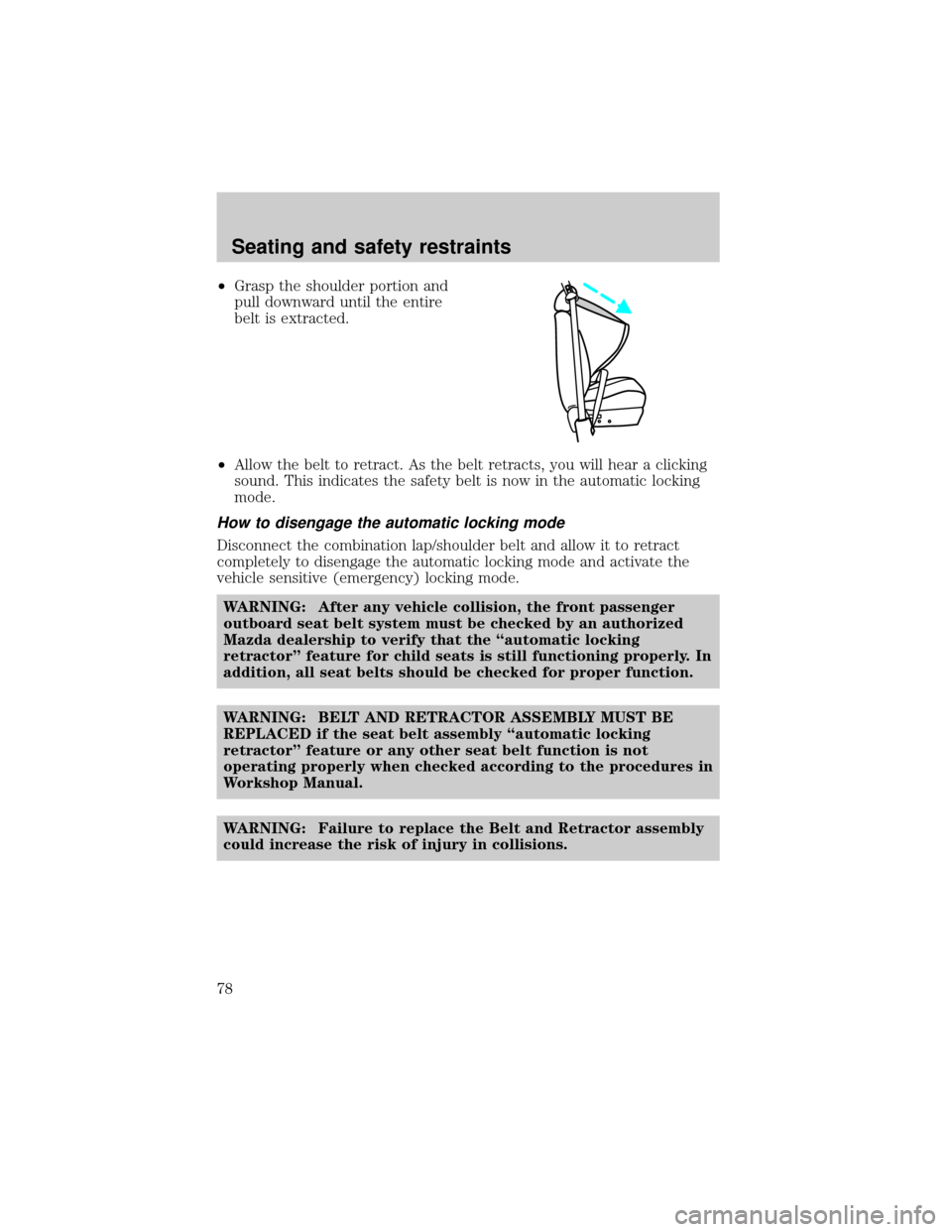
²Grasp the shoulder portion and
pull downward until the entire
belt is extracted.
²Allow the belt to retract. As the belt retracts, you will hear a clicking
sound. This indicates the safety belt is now in the automatic locking
mode.
How to disengage the automatic locking mode
Disconnect the combination lap/shoulder belt and allow it to retract
completely to disengage the automatic locking mode and activate the
vehicle sensitive (emergency) locking mode.
WARNING: After any vehicle collision, the front passenger
outboard seat belt system must be checked by an authorized
Mazda dealership to verify that the ªautomatic locking
retractorº feature for child seats is still functioning properly. In
addition, all seat belts should be checked for proper function.
WARNING: BELT AND RETRACTOR ASSEMBLY MUST BE
REPLACED if the seat belt assembly ªautomatic locking
retractorº feature or any other seat belt function is not
operating properly when checked according to the procedures in
Workshop Manual.
WARNING: Failure to replace the Belt and Retractor assembly
could increase the risk of injury in collisions.
Seating and safety restraints
78
Page 79 of 232
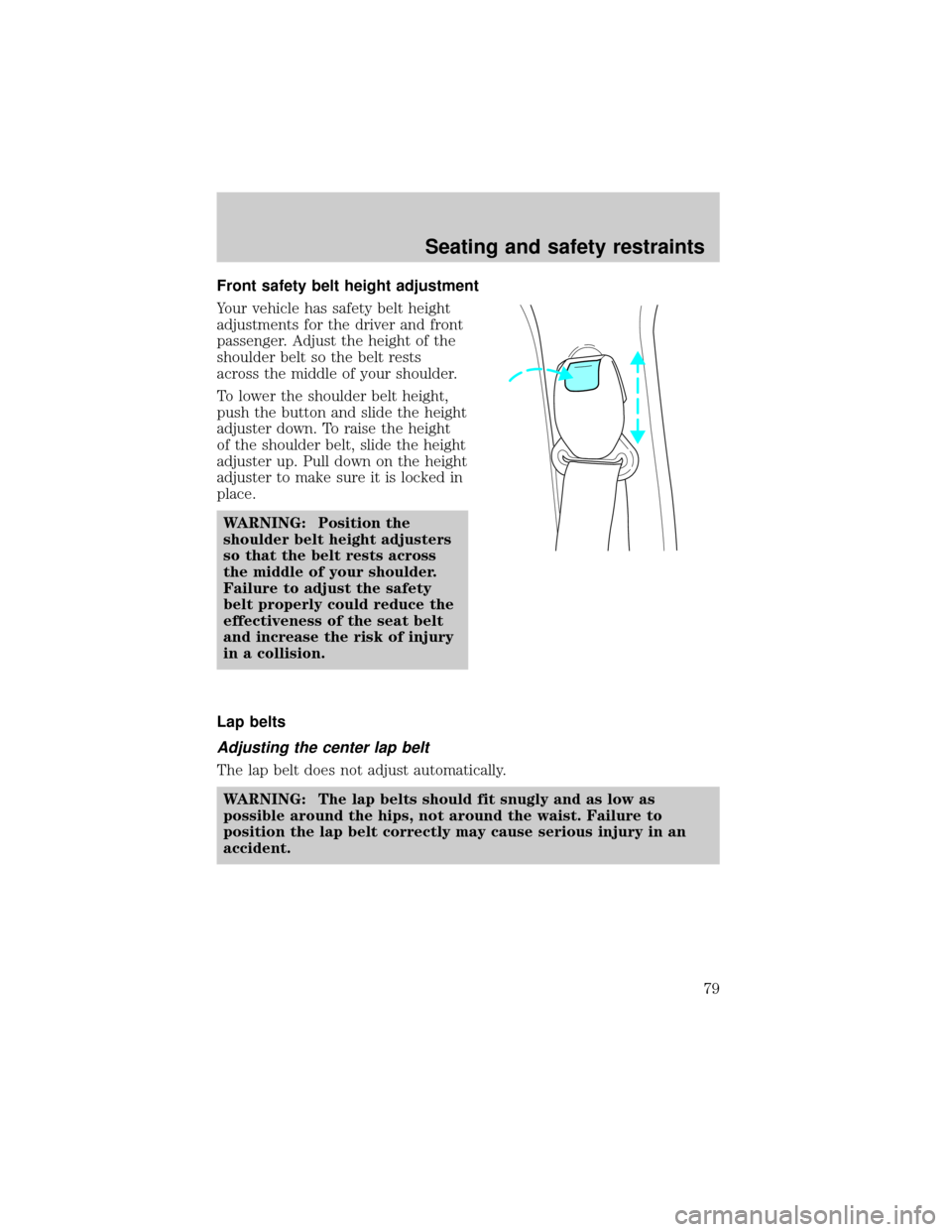
Front safety belt height adjustment
Your vehicle has safety belt height
adjustments for the driver and front
passenger. Adjust the height of the
shoulder belt so the belt rests
across the middle of your shoulder.
To lower the shoulder belt height,
push the button and slide the height
adjuster down. To raise the height
of the shoulder belt, slide the height
adjuster up. Pull down on the height
adjuster to make sure it is locked in
place.
WARNING: Position the
shoulder belt height adjusters
so that the belt rests across
the middle of your shoulder.
Failure to adjust the safety
belt properly could reduce the
effectiveness of the seat belt
and increase the risk of injury
in a collision.
Lap belts
Adjusting the center lap belt
The lap belt does not adjust automatically.
WARNING: The lap belts should fit snugly and as low as
possible around the hips, not around the waist. Failure to
position the lap belt correctly may cause serious injury in an
accident.
Seating and safety restraints
79
Page 80 of 232
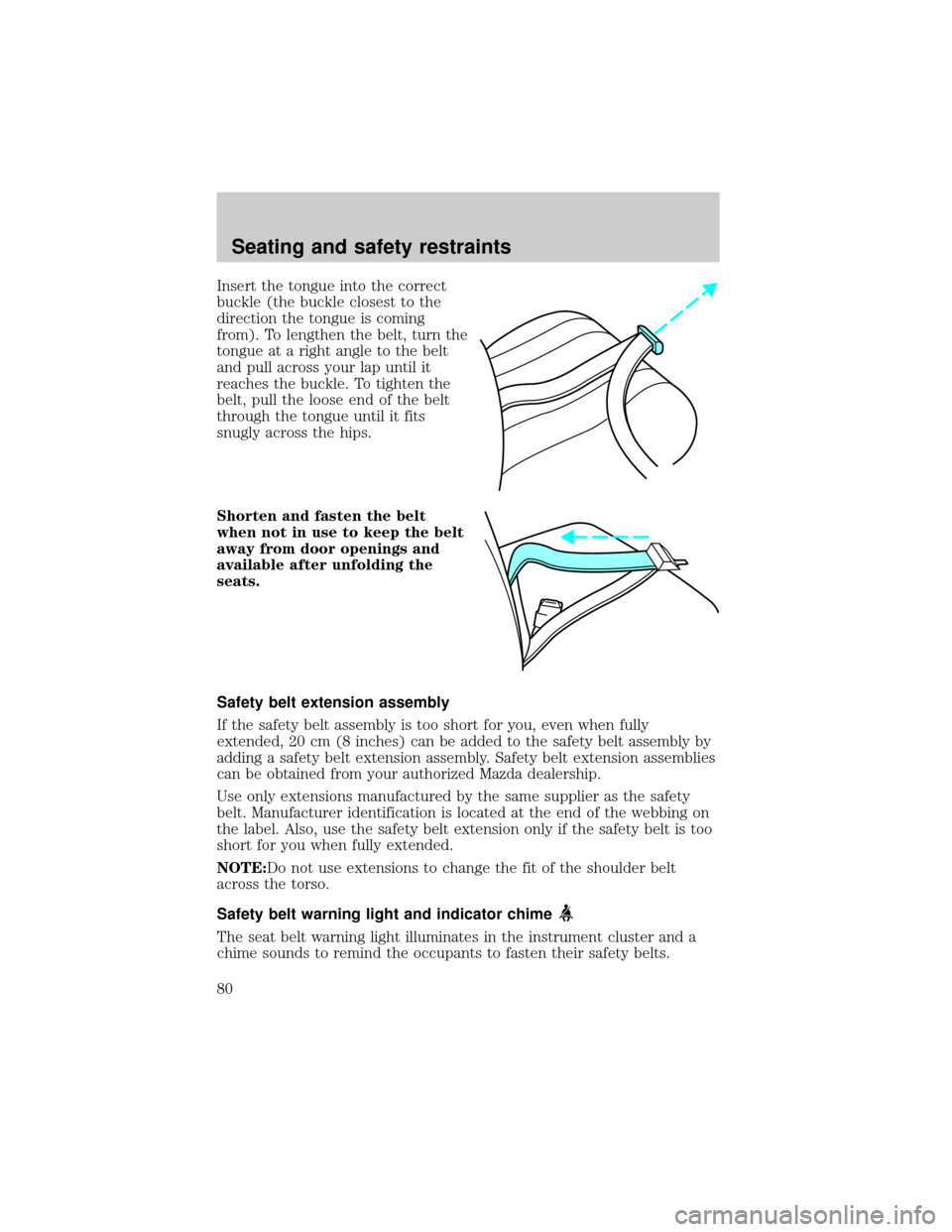
Insert the tongue into the correct
buckle (the buckle closest to the
direction the tongue is coming
from). To lengthen the belt, turn the
tongue at a right angle to the belt
and pull across your lap until it
reaches the buckle. To tighten the
belt, pull the loose end of the belt
through the tongue until it fits
snugly across the hips.
Shorten and fasten the belt
when not in use to keep the belt
away from door openings and
available after unfolding the
seats.
Safety belt extension assembly
If the safety belt assembly is too short for you, even when fully
extended, 20 cm (8 inches) can be added to the safety belt assembly by
adding a safety belt extension assembly. Safety belt extension assemblies
can be obtained from your authorized Mazda dealership.
Use only extensions manufactured by the same supplier as the safety
belt. Manufacturer identification is located at the end of the webbing on
the label. Also, use the safety belt extension only if the safety belt is too
short for you when fully extended.
NOTE:Do not use extensions to change the fit of the shoulder belt
across the torso.
Safety belt warning light and indicator chime
The seat belt warning light illuminates in the instrument cluster and a
chime sounds to remind the occupants to fasten their safety belts.
Seating and safety restraints
80